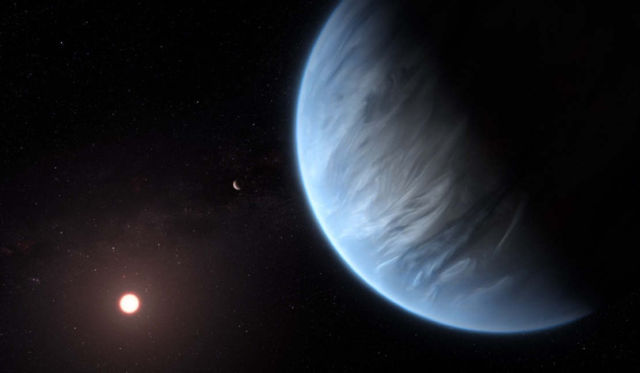First super-Earth exoplanet discovered with water vapor, orbiting in the habitable zone of its star, which may hold alien life.
Researchers at UCL have detected water vapor and habitable temperatures in the atmosphere of K2-18b, which is eight times the mass of Earth.
With data from the NASA/ESA Hubble Space Telescope, water vapour has been detected in the atmosphere of a super-Earth within the habitable zone, by University College London (UCL) researchers in a world first.
K2-18b is now the only planet orbiting a star outside the Solar System, or exoplanet, known to have both water and temperatures that could support life.
The discovery, published today in Nature Astronomy, is the first successful atmospheric detection of an exoplanet orbiting in its star’s habitable zone, at a distance where water can exist in liquid form.
First author, Dr Angelos Tsiaras (UCL Centre for Space Exochemistry Data,CSED), said: “Finding water on a potentially habitable world other than Earth is incredibly exciting. K2-18b is not ‘Earth 2.0’ as it is significantly heavier and has a different atmospheric composition. However, it brings us closer to answering the fundamental question: Is the Earth unique?”
The team used archive data from 2016 and 2017 captured by the NASA/ESA Hubble Space Telescope and developed open-source algorithms to analyse the starlight filtered through K2-18b’s atmosphere. The results revealed the molecular signature of water vapour, also indicating the presence of hydrogen and helium in the planet’s atmosphere.
The authors believe that other molecules, including nitrogen and methane, may be present but they remain undetectable with current observations. Further studies are required to estimate cloud coverage and the percentage of atmospheric water present.
The planet orbits the cool dwarf star K2-18, which is 110 light years from Earth in the constellation of Leo. Given the high level of activity of its red dwarf star, K2-18b may be more hostile than Earth and is likely to be exposed to more radiation.
K2-18b was discovered in 2015 and is one of hundreds of super-Earths — planets with masses between those of Earth and Neptune — found by NASA’s Kepler spacecraft. NASA’s TESS mission is expected to detect hundreds more super-Earths in the coming years.
Co-author Dr Ingo Waldmann (UCL CSED), said: “With so many new super-Earths expected to be found over the next couple of decades, it is likely that this is the first discovery of many potentially habitable planets. This is not only because super-Earths like K2-18b are the most common planets in our Milky Way, but also because red dwarfs — stars smaller than our Sun — are the most common stars.”
The next generation of space telescopes, including the NASA/ESA/CSA James Webb Space Telescope and ESA’s ARIEL mission, will be able to characterise atmospheres in more detail as they will carry more advanced instruments. ARIEL is expected to launch in 2028 and will observe 1,000 planets in detail to get a truly representative picture of what they are like.
Professor Giovanna Tinetti (UCL CSED), co-author and Principal Investigator for ARIEL, said: “Our discovery makes K2-18b one of the most interesting targets for future study. Over 4000 exoplanets have been detected but we don’t know much about their composition and nature. By observing a large sample of planets, we hope to reveal secrets about their chemistry, formation and evolution.”
“This study contributes to our understanding of habitable worlds beyond our Solar System and marks a new era in exoplanet research, crucial to ultimately placing the Earth, our only home, into the greater picture of the Cosmos,” said Dr Tsiaras.
Image credit ESA/Hubble/M. Kornmesser
source Hubble Space Telescope






Leave A Comment